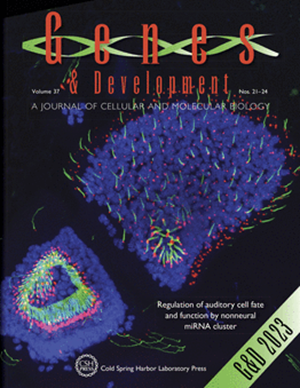TEAD switches interacting partners along neural progenitor lineage progression to execute distinct functions
IF 7.7
1区 生物学
Q1 CELL BIOLOGY
引用次数: 0
Abstract
The TEAD family of transcription factors is best known as the DNA-binding factor in the Hippo pathway, where these factors act by interacting with transcriptional coactivators YAP and TAZ (YAP/TAZ). Despite the importance of the Hippo pathway, the in vivo functions of TEAD in mammals have not been well established. By comparing mouse mutants lacking TEAD1 and TEAD2 (TEAD1/2) with those lacking YAP/TAZ, we found that TEAD1/2 have both YAP/TAZ-dependent and YAP/TAZ-independent functions during ventral telencephalon development. TEAD1/2 loss and YAP/TAZ loss similarly disrupt neuroepithelial apical junctions. However, the impacts of their losses on progenitor lineage progression are essentially opposite: YAP/TAZ loss depletes early progenitors and increases later progenitors, consistent with their established function in promoting progenitor self-renewal and proliferation, whereas TEAD1/2 loss expands early progenitors and reduces late progenitors, indicating that TEAD1/2 promote lineage progression. We further show that TEAD1/2 promote neural progenitor lineage progression by at least in part inhibiting Notch signaling and by cooperating with insulinoma-associated 1 (INSM1). Orthologs of TEAD and INSM1 have been shown to cooperatively regulate neuronal cell fate decisions in worms and flies. Our study reveals a remarkable evolutionary conservation of the function of this transcription factor complex during metazoan neural development.TEAD沿着神经祖谱系的进展切换相互作用的伙伴来执行不同的功能
TEAD家族转录因子是Hippo通路中最著名的dna结合因子,这些因子通过与转录共激活因子YAP和TAZ (YAP/TAZ)相互作用而起作用。尽管河马通路的重要性,TEAD在哺乳动物体内的功能尚未得到很好的确定。通过比较缺乏TEAD1和TEAD2的小鼠突变体(TEAD1/2)与缺乏YAP/TAZ的小鼠突变体,我们发现TEAD1/2在腹端脑发育过程中同时具有YAP/TAZ依赖性和YAP/TAZ非依赖性功能。TEAD1/2缺失和YAP/TAZ缺失同样会破坏神经上皮顶端连接。然而,它们的缺失对祖细胞谱系进展的影响本质上是相反的:YAP/TAZ的缺失消耗了早期祖细胞,增加了晚期祖细胞,这与它们促进祖细胞自我更新和增殖的既定功能一致,而TEAD1/2的缺失扩大了早期祖细胞,减少了晚期祖细胞,这表明TEAD1/2促进了谱系进展。我们进一步表明,TEAD1/2通过至少部分抑制Notch信号传导并与胰岛素瘤相关1 (INSM1)合作,促进神经祖细胞谱系的进展。在蠕虫和果蝇中,TEAD和INSM1的同源物已被证明协同调节神经元细胞的命运决定。我们的研究揭示了在后生动物神经发育过程中这种转录因子复合物功能的显著进化守恒。
本文章由计算机程序翻译,如有差异,请以英文原文为准。
求助全文
约1分钟内获得全文
求助全文
来源期刊

Genes & development
生物-发育生物学
CiteScore
17.50
自引率
1.90%
发文量
71
审稿时长
3-6 weeks
期刊介绍:
Genes & Development is a research journal published in association with The Genetics Society. It publishes high-quality research papers in the areas of molecular biology, molecular genetics, and related fields. The journal features various research formats including Research papers, short Research Communications, and Resource/Methodology papers.
Genes & Development has gained recognition and is considered as one of the Top Five Research Journals in the field of Molecular Biology and Genetics. It has an impressive Impact Factor of 12.89. The journal is ranked #2 among Developmental Biology research journals, #5 in Genetics and Heredity, and is among the Top 20 in Cell Biology (according to ISI Journal Citation Reports®, 2021).
 求助内容:
求助内容: 应助结果提醒方式:
应助结果提醒方式:


